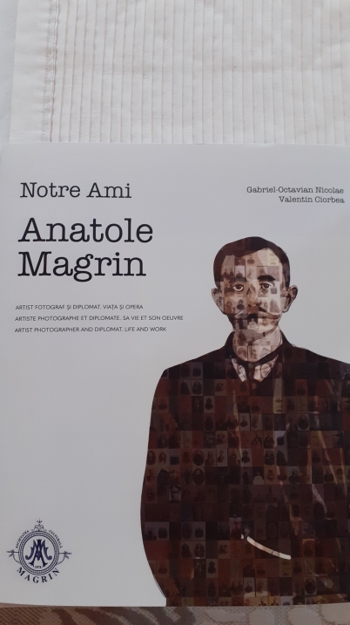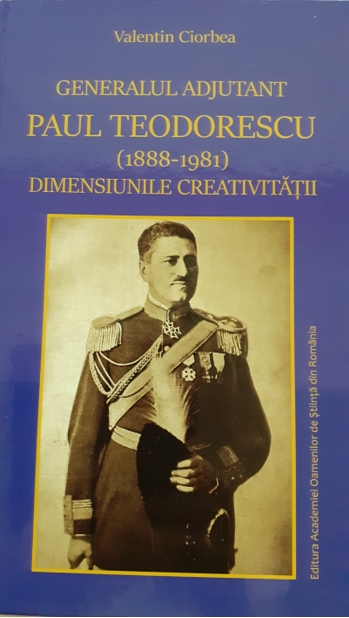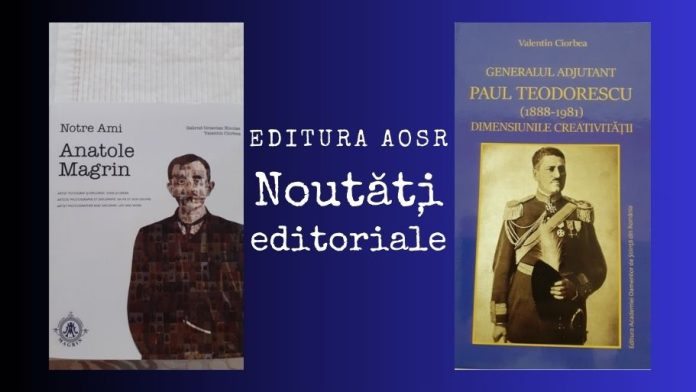We would like to point out two new publications from the Academy of Romanian Scientists:
Nicolae Gabriel-Octavian, Valentin Ciorbea. Our friend Anatole Magrin: artist photographer and diplomat: life and work/ Artiste photographe et diplomate. His life and work/ Artist Photographer and Diplomat. Life and Work.
Bucharest: Publishing House of the Academy of Romanian Scientists, 2023.
English translation – Nicoleta Stanca
French translation – Ion Dumitrașcu
236 pp.

In exceptional graphic conditions, Gabriel-Octavian Nicolae and Valentin Ciorbea publish a large album in a trilingual edition, Romanian-French-English, dedicated to the first photographer of Dobrogea, Anatole Magrin, the Frenchman from Dobrogea who left to posterity the first images of the region between the Danube and the Black Sea after the union with Romania after 1878. Settled in Constanta in the autumn of 1878, Anatole Magrin carried out a complex activity in the Constantine community and as a diplomat vice-consul of France.
The beautiful achievement of the two is prefaced by Her Excellency Laurence Auer, Ambassador of the Republic of France in Romania, Vergil Chițac, Mayor of Constanta, Romeo Stavăr-Vergea, Honorary Consul of France in Constanta and Dorin Popescu, Cultural Advisor to the Mayor of Constanta.
The authors take their readers through the life of Anatole Magrin, born in France on 9 December 1858, who settled in Constanta in 1878, where he lived until 1928. A gifted photographer, he often left his studio with his camera to capture general images of Dobrogea, details of various localities, etc.
The exceptional value of the album is the illustrations, the photographs of Magrin’s native places, but especially of Constanța and Dobrogea. The preserved photographs, collected with great effort in the personal collection of Gabriel-Octavian Nicolae, allow us to see how Tulcea, Babadag, Mangalia, Adamclisi and Constanta looked like at various times of the evolution after 1878. Streets, neighbourhoods, buildings, the harbour and various ships can be seen. Impressive are the images of the inhabitants of Dobrogea, the photographer Magrin capturing the multi-ethnic specificity of the region. For the value of his work he was awarded a medal in Paris and elevated to the status of supplier to the Royal Court.
Romanian and foreign readers who browse through the impressive album will have the opportunity to appreciate Anatole Magrin’s exceptional contribution to the art of photography and to relations between Romania and France.
Valentin Ciorbea, Adjutant General Paul Teodorescu (1888-1981). Dimensions of creativity
Publishing House of the Academy of Romanian Scientists, Bucharest, 2023, 357 p.

Prof. Dr. Valentin Ciorbea, full member of AOSR, presents readers with a comprehensive monograph on the life and work of Adjutant General Paul Teodorescu on his 135th birthday.
General Paul Teodorescu dedicated his life to the great institutions of the Romanian people: the Army, the School and the Church. The author takes the reader back to his childhood, family life, school years, which the young Paul Teodorescu went through. He began his career as a platoon commander and ended it with the rank of general, division commander. He fought in two wars: The Second Balkan War and the First World War. He did brilliant studies in France. Back in the country, he was a professor at the Higher War School, combining his work at the department with scientific research. As Chief of Staff of the Aeronautics Inspectorate, he played a major role in the organization of the structure and development of this field.
As commander of the “Mihai Viteazul” Guards Regiment, he transformed the unit into a unique model in Romania and made it known abroad.
He was a military diplomat in France and director of the Higher War College, a position from which he reformed military higher education and initiated the construction of the Cotroceni campus. As a minister in ten governments he left remarkable achievements.
During the communist regime he was imprisoned, deprived of his livelihood, forced to fight the authorities for survival.
His scientific research has been exploited in books, studies and manuscripts. The Romanian Academy of Sciences and the Romanian Academy recognized his merits and elected him as a full and corresponding member respectively.
Raised in a family with strong religious convictions, he paid particular attention to the Orthodox Church throughout his life. He was a founder and renovator of places of worship. The most lasting of his achievements is the consecration of the Wooden Monastery as the Holy Place of the Air Force and Navy.
Professor Ciorbea brings in the pages of the book the last years of the General’s life, retired to the Monastery of Dintr-un Lemn, where he was buried in the cemetery of the Holy Place.
In his foreword, the renowned historian Prof. Petre Otu concludes: “As a result of this prodigious effort, Professor Ciorbea has the great merit of having imposed, or rather reimposed, the personality of Adjutant General Paul Teodorescu in historiography, especially in the military and in public opinion. Therefore, the monograph published under the auspices of the Academy of Scientists, of which he is a full member, is a work of synthesis, of maturity, which crowns a remarkable scientific activity”..


